Action Plan Development for Innovation and Creativity
VerifiedAdded on 2023/01/19
|15
|3631
|25
AI Summary
The report focuses on the development of an action plan for promoting innovation and creativity in the business organization. It discusses the use of Amabile and Osborn Parnes models, the role of Knowledge Transfer Partnership, and the importance of rewards and recognition. The report also highlights the case study of Drax UK Ltd. and its efforts to improve market share through innovation.
Contribute Materials
Your contribution can guide someone’s learning journey. Share your
documents today.

Running head: MANAGEMENT
Management
Name of student
Name of University
Author note
Management
Name of student
Name of University
Author note
Secure Best Marks with AI Grader
Need help grading? Try our AI Grader for instant feedback on your assignments.
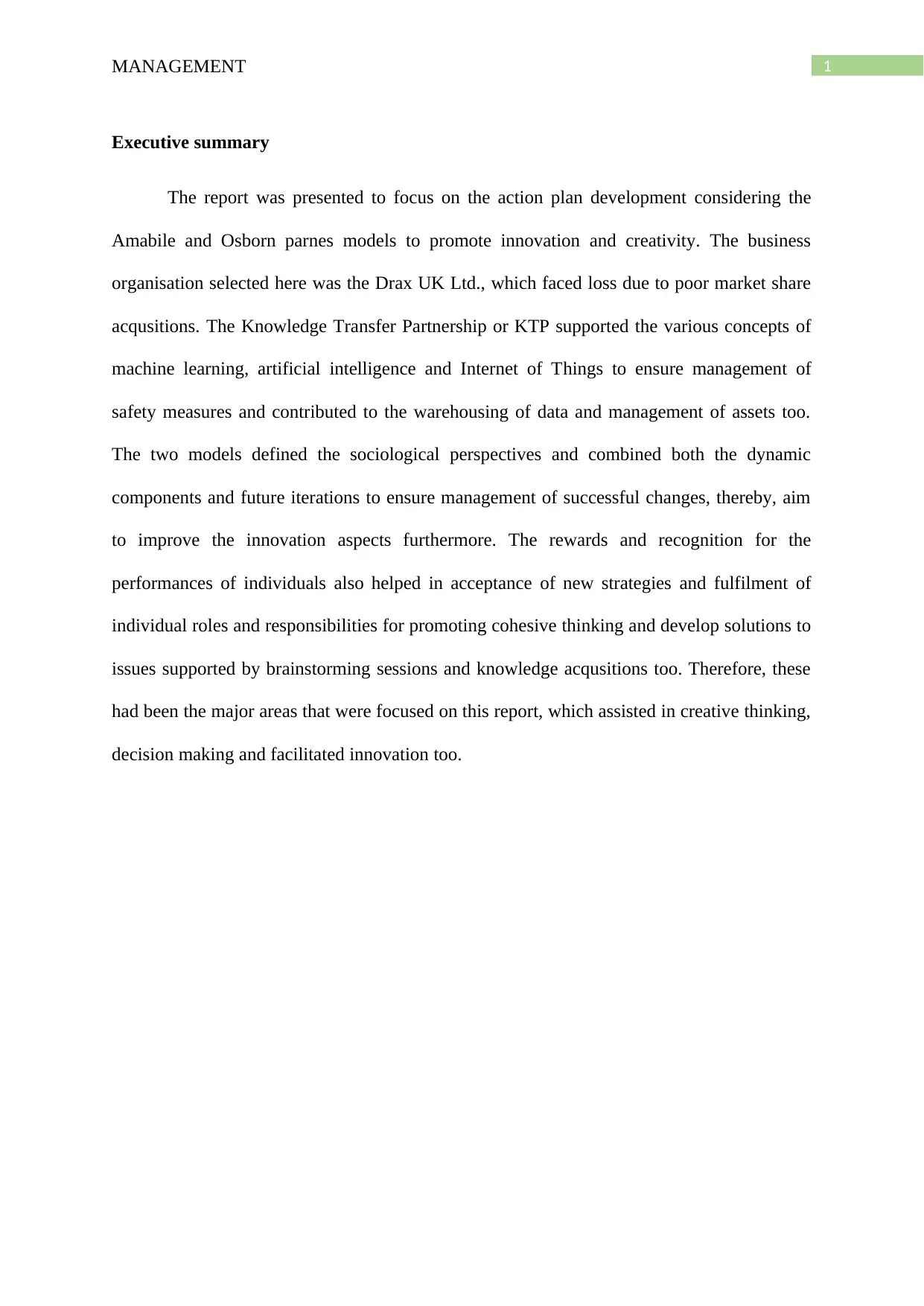
1MANAGEMENT
Executive summary
The report was presented to focus on the action plan development considering the
Amabile and Osborn parnes models to promote innovation and creativity. The business
organisation selected here was the Drax UK Ltd., which faced loss due to poor market share
acqusitions. The Knowledge Transfer Partnership or KTP supported the various concepts of
machine learning, artificial intelligence and Internet of Things to ensure management of
safety measures and contributed to the warehousing of data and management of assets too.
The two models defined the sociological perspectives and combined both the dynamic
components and future iterations to ensure management of successful changes, thereby, aim
to improve the innovation aspects furthermore. The rewards and recognition for the
performances of individuals also helped in acceptance of new strategies and fulfilment of
individual roles and responsibilities for promoting cohesive thinking and develop solutions to
issues supported by brainstorming sessions and knowledge acqusitions too. Therefore, these
had been the major areas that were focused on this report, which assisted in creative thinking,
decision making and facilitated innovation too.
Executive summary
The report was presented to focus on the action plan development considering the
Amabile and Osborn parnes models to promote innovation and creativity. The business
organisation selected here was the Drax UK Ltd., which faced loss due to poor market share
acqusitions. The Knowledge Transfer Partnership or KTP supported the various concepts of
machine learning, artificial intelligence and Internet of Things to ensure management of
safety measures and contributed to the warehousing of data and management of assets too.
The two models defined the sociological perspectives and combined both the dynamic
components and future iterations to ensure management of successful changes, thereby, aim
to improve the innovation aspects furthermore. The rewards and recognition for the
performances of individuals also helped in acceptance of new strategies and fulfilment of
individual roles and responsibilities for promoting cohesive thinking and develop solutions to
issues supported by brainstorming sessions and knowledge acqusitions too. Therefore, these
had been the major areas that were focused on this report, which assisted in creative thinking,
decision making and facilitated innovation too.
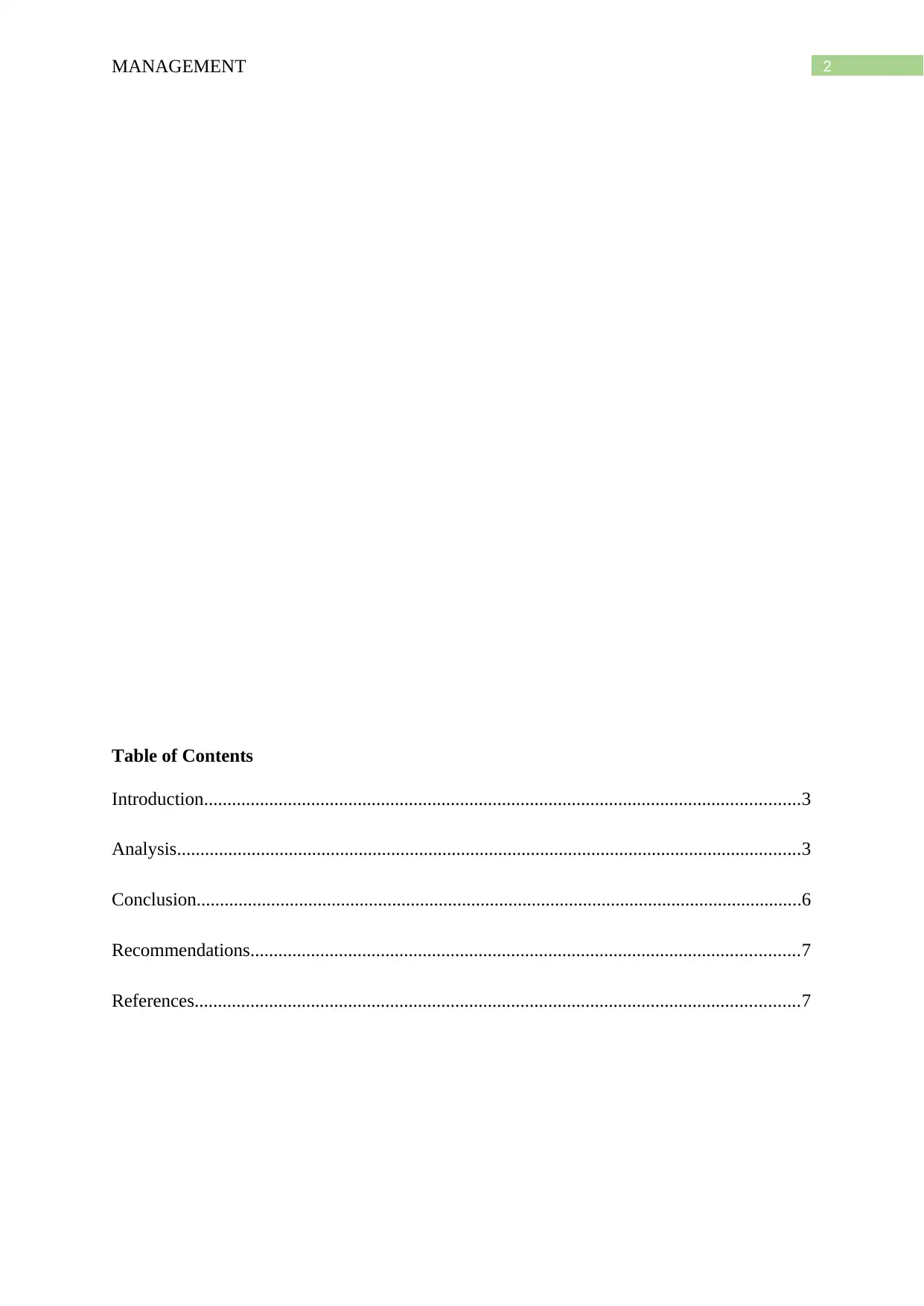
2MANAGEMENT
Table of Contents
Introduction................................................................................................................................3
Analysis......................................................................................................................................3
Conclusion..................................................................................................................................6
Recommendations......................................................................................................................7
References..................................................................................................................................7
Table of Contents
Introduction................................................................................................................................3
Analysis......................................................................................................................................3
Conclusion..................................................................................................................................6
Recommendations......................................................................................................................7
References..................................................................................................................................7

3MANAGEMENT
Introduction
The report is prepared to demonstrate about the development of an effective plan for
the purpose of enabling creativity, innovation and manage corporate entrepreneurship with
ease and efficiency considering the business organisation named Drax UK Ltd. The
assignment focuses on the management of creativity and innovation at the organisation and
how it has managed to introduce a systematic process for allowing major changes and remain
adaptable to the creative environment. The topic will also shed light on the different models,
especially the amabile componential model and the Osborn parnes model to understand how
the processes and structure methods have been managed with the help of brainstorming and
thinking skills (Amabile and Pratt 2016). It will not only facilitate the creative thinking, but
can also help in generating new ideas and concepts, furthermore ensure proper management
of creative processes along with finding the most suitable resources for managing sustainable
innovation rather than disruptive innovations while partnering with the KTP project.
Drax Services UK Ltd is one of the major companies that manages selling of fire
detection and alarm systems, alarm management systems and other safety systems to
different market segments such as the educational institutions, Government, retail, healthcare,
manufacturing, transport and commercial fields too. The company made sure to operate
effectively though the market share has been losing from time to time, which has enabled to
focus again on the hardware and software aspects by using the concepts of machine learning,
Internet-of-things (IoT) and artificial intelligence (Draxtechnology.com 2019). The
innovation is supported with the involvement of Knowledge Transfer Partnership or KTP,
funded by the Innovate UK to facilitate innovation and creativity, furthermore ensure
maintaining safety, deliver secure data and manage data warehousing along with monitoring
of assets consistently.
Introduction
The report is prepared to demonstrate about the development of an effective plan for
the purpose of enabling creativity, innovation and manage corporate entrepreneurship with
ease and efficiency considering the business organisation named Drax UK Ltd. The
assignment focuses on the management of creativity and innovation at the organisation and
how it has managed to introduce a systematic process for allowing major changes and remain
adaptable to the creative environment. The topic will also shed light on the different models,
especially the amabile componential model and the Osborn parnes model to understand how
the processes and structure methods have been managed with the help of brainstorming and
thinking skills (Amabile and Pratt 2016). It will not only facilitate the creative thinking, but
can also help in generating new ideas and concepts, furthermore ensure proper management
of creative processes along with finding the most suitable resources for managing sustainable
innovation rather than disruptive innovations while partnering with the KTP project.
Drax Services UK Ltd is one of the major companies that manages selling of fire
detection and alarm systems, alarm management systems and other safety systems to
different market segments such as the educational institutions, Government, retail, healthcare,
manufacturing, transport and commercial fields too. The company made sure to operate
effectively though the market share has been losing from time to time, which has enabled to
focus again on the hardware and software aspects by using the concepts of machine learning,
Internet-of-things (IoT) and artificial intelligence (Draxtechnology.com 2019). The
innovation is supported with the involvement of Knowledge Transfer Partnership or KTP,
funded by the Innovate UK to facilitate innovation and creativity, furthermore ensure
maintaining safety, deliver secure data and manage data warehousing along with monitoring
of assets consistently.
Paraphrase This Document
Need a fresh take? Get an instant paraphrase of this document with our AI Paraphraser
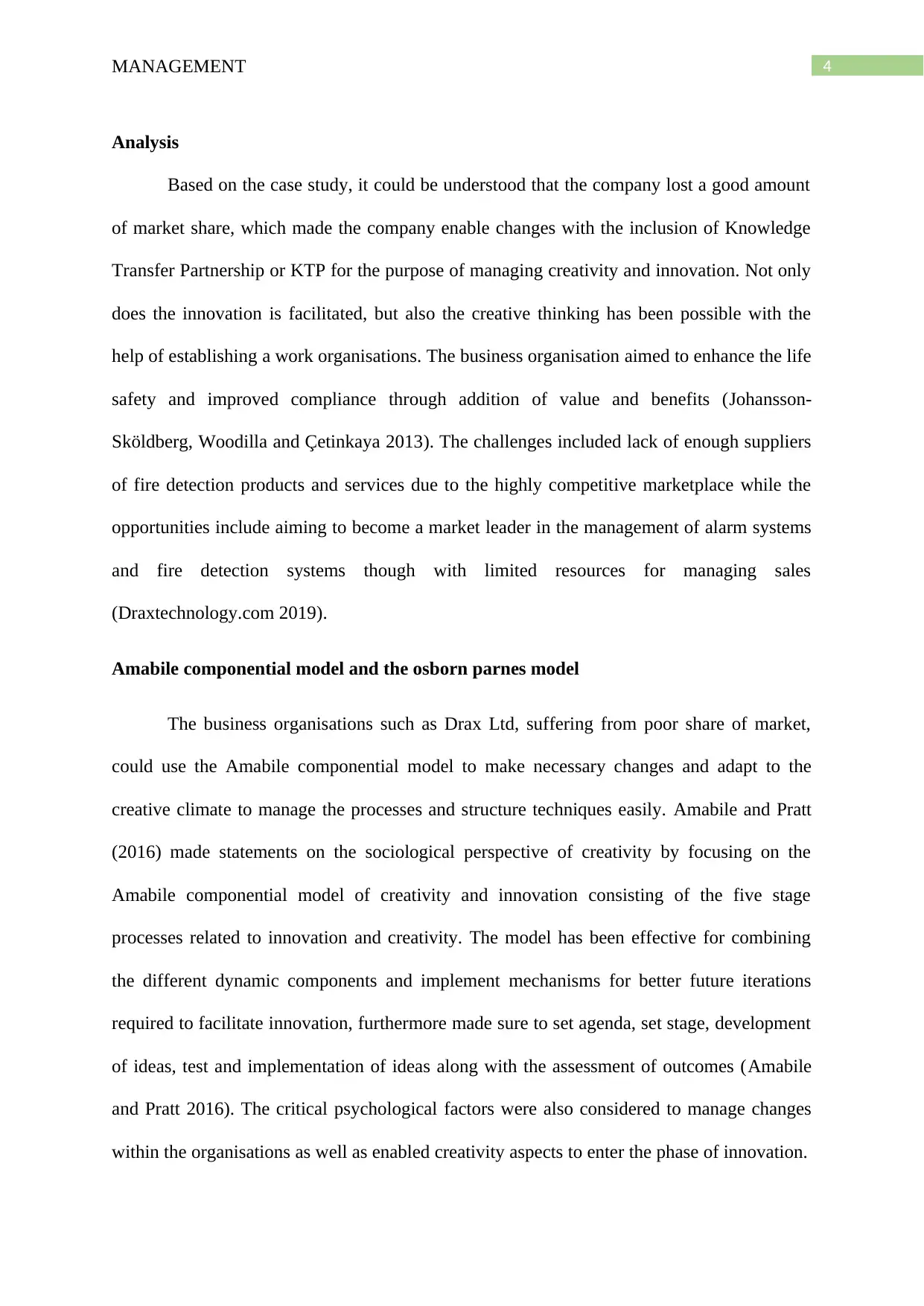
4MANAGEMENT
Analysis
Based on the case study, it could be understood that the company lost a good amount
of market share, which made the company enable changes with the inclusion of Knowledge
Transfer Partnership or KTP for the purpose of managing creativity and innovation. Not only
does the innovation is facilitated, but also the creative thinking has been possible with the
help of establishing a work organisations. The business organisation aimed to enhance the life
safety and improved compliance through addition of value and benefits (Johansson‐
Sköldberg, Woodilla and Çetinkaya 2013). The challenges included lack of enough suppliers
of fire detection products and services due to the highly competitive marketplace while the
opportunities include aiming to become a market leader in the management of alarm systems
and fire detection systems though with limited resources for managing sales
(Draxtechnology.com 2019).
Amabile componential model and the osborn parnes model
The business organisations such as Drax Ltd, suffering from poor share of market,
could use the Amabile componential model to make necessary changes and adapt to the
creative climate to manage the processes and structure techniques easily. Amabile and Pratt
(2016) made statements on the sociological perspective of creativity by focusing on the
Amabile componential model of creativity and innovation consisting of the five stage
processes related to innovation and creativity. The model has been effective for combining
the different dynamic components and implement mechanisms for better future iterations
required to facilitate innovation, furthermore made sure to set agenda, set stage, development
of ideas, test and implementation of ideas along with the assessment of outcomes (Amabile
and Pratt 2016). The critical psychological factors were also considered to manage changes
within the organisations as well as enabled creativity aspects to enter the phase of innovation.
Analysis
Based on the case study, it could be understood that the company lost a good amount
of market share, which made the company enable changes with the inclusion of Knowledge
Transfer Partnership or KTP for the purpose of managing creativity and innovation. Not only
does the innovation is facilitated, but also the creative thinking has been possible with the
help of establishing a work organisations. The business organisation aimed to enhance the life
safety and improved compliance through addition of value and benefits (Johansson‐
Sköldberg, Woodilla and Çetinkaya 2013). The challenges included lack of enough suppliers
of fire detection products and services due to the highly competitive marketplace while the
opportunities include aiming to become a market leader in the management of alarm systems
and fire detection systems though with limited resources for managing sales
(Draxtechnology.com 2019).
Amabile componential model and the osborn parnes model
The business organisations such as Drax Ltd, suffering from poor share of market,
could use the Amabile componential model to make necessary changes and adapt to the
creative climate to manage the processes and structure techniques easily. Amabile and Pratt
(2016) made statements on the sociological perspective of creativity by focusing on the
Amabile componential model of creativity and innovation consisting of the five stage
processes related to innovation and creativity. The model has been effective for combining
the different dynamic components and implement mechanisms for better future iterations
required to facilitate innovation, furthermore made sure to set agenda, set stage, development
of ideas, test and implementation of ideas along with the assessment of outcomes (Amabile
and Pratt 2016). The critical psychological factors were also considered to manage changes
within the organisations as well as enabled creativity aspects to enter the phase of innovation.
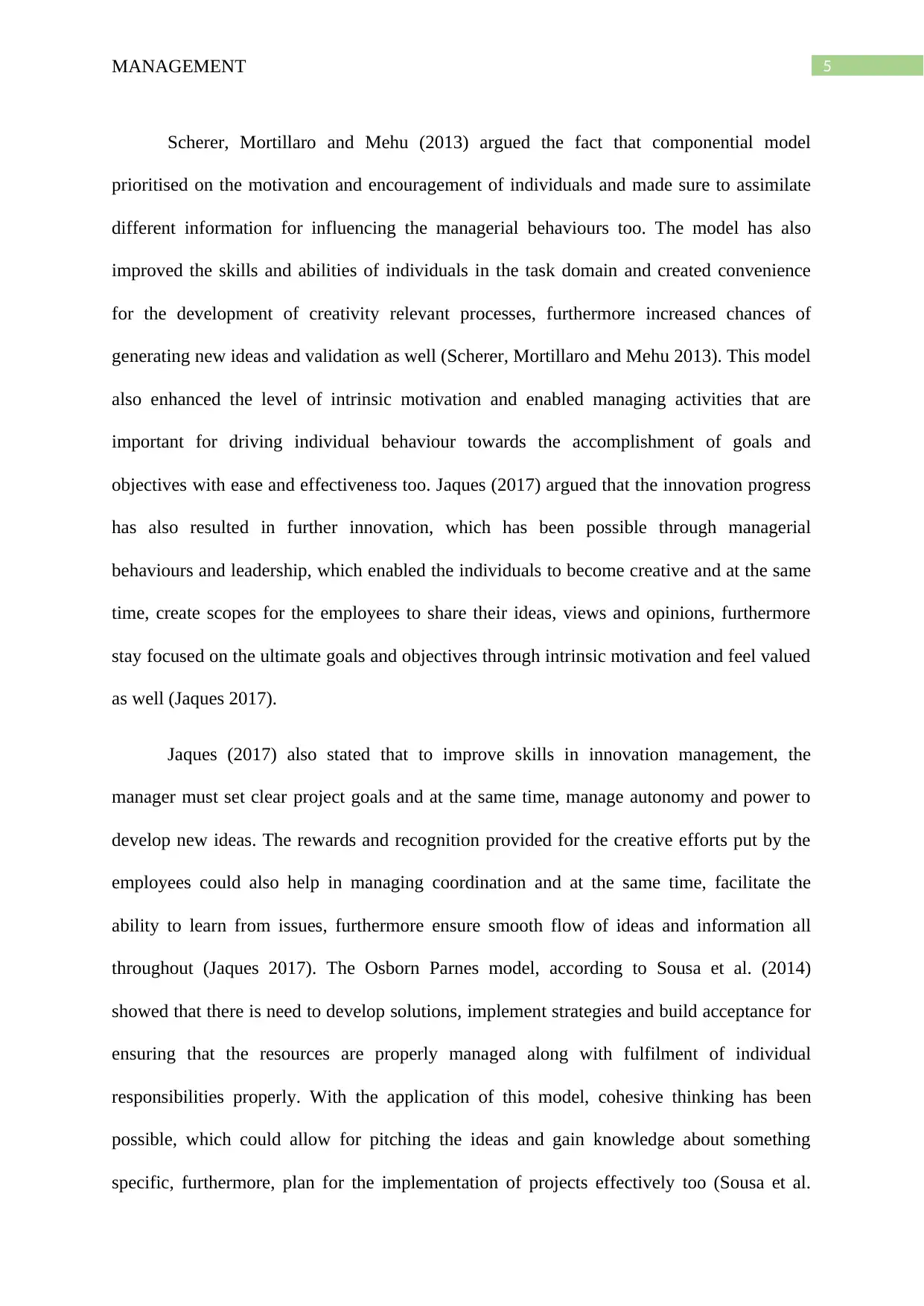
5MANAGEMENT
Scherer, Mortillaro and Mehu (2013) argued the fact that componential model
prioritised on the motivation and encouragement of individuals and made sure to assimilate
different information for influencing the managerial behaviours too. The model has also
improved the skills and abilities of individuals in the task domain and created convenience
for the development of creativity relevant processes, furthermore increased chances of
generating new ideas and validation as well (Scherer, Mortillaro and Mehu 2013). This model
also enhanced the level of intrinsic motivation and enabled managing activities that are
important for driving individual behaviour towards the accomplishment of goals and
objectives with ease and effectiveness too. Jaques (2017) argued that the innovation progress
has also resulted in further innovation, which has been possible through managerial
behaviours and leadership, which enabled the individuals to become creative and at the same
time, create scopes for the employees to share their ideas, views and opinions, furthermore
stay focused on the ultimate goals and objectives through intrinsic motivation and feel valued
as well (Jaques 2017).
Jaques (2017) also stated that to improve skills in innovation management, the
manager must set clear project goals and at the same time, manage autonomy and power to
develop new ideas. The rewards and recognition provided for the creative efforts put by the
employees could also help in managing coordination and at the same time, facilitate the
ability to learn from issues, furthermore ensure smooth flow of ideas and information all
throughout (Jaques 2017). The Osborn Parnes model, according to Sousa et al. (2014)
showed that there is need to develop solutions, implement strategies and build acceptance for
ensuring that the resources are properly managed along with fulfilment of individual
responsibilities properly. With the application of this model, cohesive thinking has been
possible, which could allow for pitching the ideas and gain knowledge about something
specific, furthermore, plan for the implementation of projects effectively too (Sousa et al.
Scherer, Mortillaro and Mehu (2013) argued the fact that componential model
prioritised on the motivation and encouragement of individuals and made sure to assimilate
different information for influencing the managerial behaviours too. The model has also
improved the skills and abilities of individuals in the task domain and created convenience
for the development of creativity relevant processes, furthermore increased chances of
generating new ideas and validation as well (Scherer, Mortillaro and Mehu 2013). This model
also enhanced the level of intrinsic motivation and enabled managing activities that are
important for driving individual behaviour towards the accomplishment of goals and
objectives with ease and effectiveness too. Jaques (2017) argued that the innovation progress
has also resulted in further innovation, which has been possible through managerial
behaviours and leadership, which enabled the individuals to become creative and at the same
time, create scopes for the employees to share their ideas, views and opinions, furthermore
stay focused on the ultimate goals and objectives through intrinsic motivation and feel valued
as well (Jaques 2017).
Jaques (2017) also stated that to improve skills in innovation management, the
manager must set clear project goals and at the same time, manage autonomy and power to
develop new ideas. The rewards and recognition provided for the creative efforts put by the
employees could also help in managing coordination and at the same time, facilitate the
ability to learn from issues, furthermore ensure smooth flow of ideas and information all
throughout (Jaques 2017). The Osborn Parnes model, according to Sousa et al. (2014)
showed that there is need to develop solutions, implement strategies and build acceptance for
ensuring that the resources are properly managed along with fulfilment of individual
responsibilities properly. With the application of this model, cohesive thinking has been
possible, which could allow for pitching the ideas and gain knowledge about something
specific, furthermore, plan for the implementation of projects effectively too (Sousa et al.

6MANAGEMENT
2014). The approach to creative problem solving could be the brainstorming sessions, based
on the model, which enabled individuals within the organisation to generate ideas and
understand the source of an issue related to the design. The group members are involved,
which further facilitated the management of ideas within the free thinking environment and
thus expanded the scope for implementing a most suitable solution to overcome the problem.
The model was also implemented considering the identification of challenges and framing the
problems, which could also enable the employees to use their creative thinking skills ensure
resolving the issues with much ease and effectiveness (He, Ghobadian and Gallear 2013).
The future resources could be used by Drax to manage sustainable innovation by
partnering with the KTP project. With the use of technological resources, the company would
be able to find out new ways of water power generation, i.e., hydropower while the
investments done for research and development could enable 3D technology for
revolutionising the energy. The renewable sources of energy could also make Drax to prevent
emissions of harmful gases and at the same time, commit to the environmental policies and
laws, to reduce the negative impacts of operations. This should facilitate the creative thinking
skills and innovation aspects as well as enhance the ability to maintain sustainable
approaches to move towards innovation (Teo and Bhattacherjee 2014). The model integrated
within the KTP could also improve the flexibility of supply chains for DRAX and improve
the outsourcing capabilities to improve knowledge acqusitions and advancement of skills and
abilities to reach the business goals and attain competitive advantage (Draxtechnology.com
2019).
From the case study, it could be understood that the Knowledge Transfer Partnership
or KTP through disruptive innovation was managed by developing an intelligent dash-
boarding platform to manage the fire alarm systems while the managers were allowed to
2014). The approach to creative problem solving could be the brainstorming sessions, based
on the model, which enabled individuals within the organisation to generate ideas and
understand the source of an issue related to the design. The group members are involved,
which further facilitated the management of ideas within the free thinking environment and
thus expanded the scope for implementing a most suitable solution to overcome the problem.
The model was also implemented considering the identification of challenges and framing the
problems, which could also enable the employees to use their creative thinking skills ensure
resolving the issues with much ease and effectiveness (He, Ghobadian and Gallear 2013).
The future resources could be used by Drax to manage sustainable innovation by
partnering with the KTP project. With the use of technological resources, the company would
be able to find out new ways of water power generation, i.e., hydropower while the
investments done for research and development could enable 3D technology for
revolutionising the energy. The renewable sources of energy could also make Drax to prevent
emissions of harmful gases and at the same time, commit to the environmental policies and
laws, to reduce the negative impacts of operations. This should facilitate the creative thinking
skills and innovation aspects as well as enhance the ability to maintain sustainable
approaches to move towards innovation (Teo and Bhattacherjee 2014). The model integrated
within the KTP could also improve the flexibility of supply chains for DRAX and improve
the outsourcing capabilities to improve knowledge acqusitions and advancement of skills and
abilities to reach the business goals and attain competitive advantage (Draxtechnology.com
2019).
From the case study, it could be understood that the Knowledge Transfer Partnership
or KTP through disruptive innovation was managed by developing an intelligent dash-
boarding platform to manage the fire alarm systems while the managers were allowed to
Secure Best Marks with AI Grader
Need help grading? Try our AI Grader for instant feedback on your assignments.
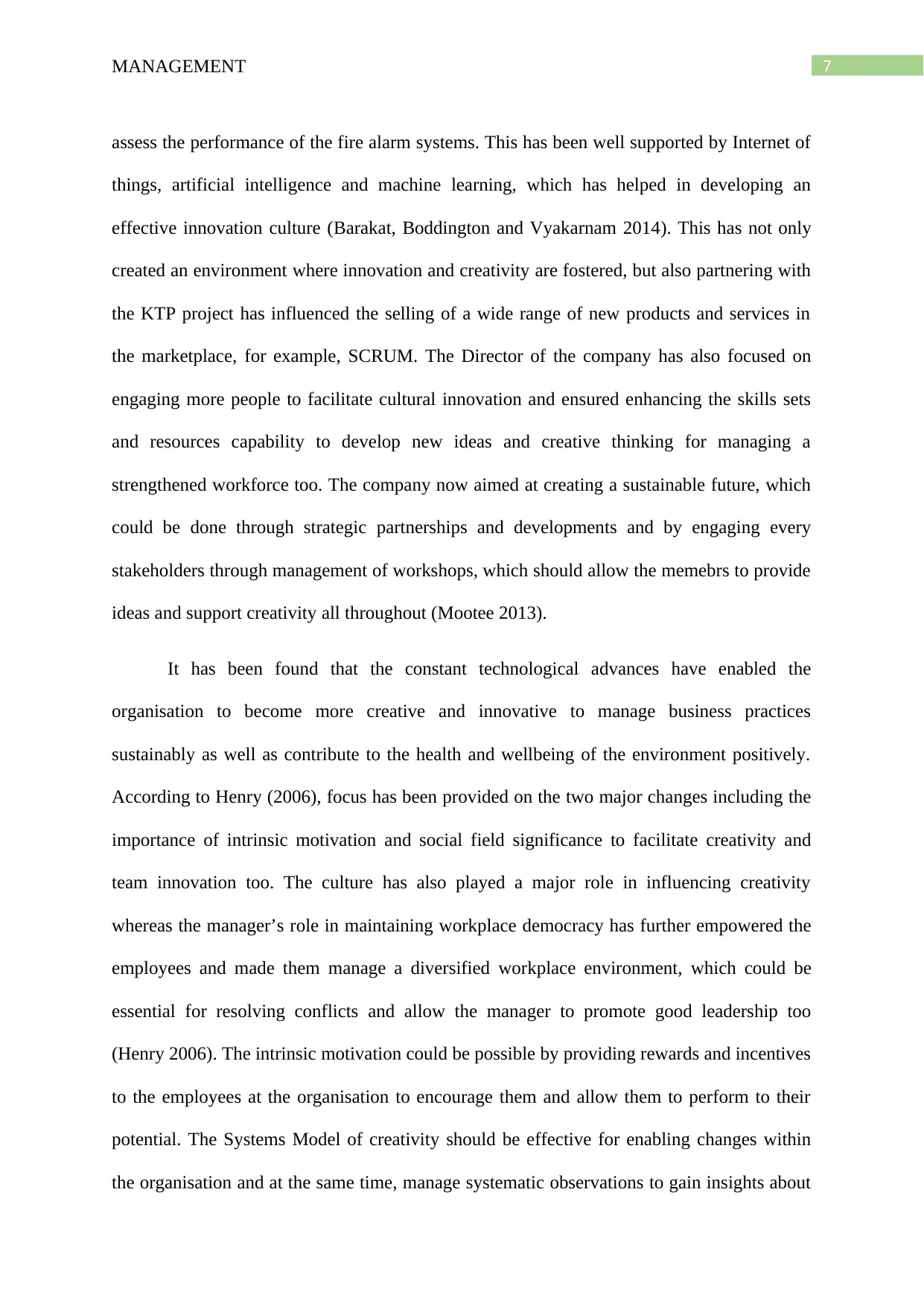
7MANAGEMENT
assess the performance of the fire alarm systems. This has been well supported by Internet of
things, artificial intelligence and machine learning, which has helped in developing an
effective innovation culture (Barakat, Boddington and Vyakarnam 2014). This has not only
created an environment where innovation and creativity are fostered, but also partnering with
the KTP project has influenced the selling of a wide range of new products and services in
the marketplace, for example, SCRUM. The Director of the company has also focused on
engaging more people to facilitate cultural innovation and ensured enhancing the skills sets
and resources capability to develop new ideas and creative thinking for managing a
strengthened workforce too. The company now aimed at creating a sustainable future, which
could be done through strategic partnerships and developments and by engaging every
stakeholders through management of workshops, which should allow the memebrs to provide
ideas and support creativity all throughout (Mootee 2013).
It has been found that the constant technological advances have enabled the
organisation to become more creative and innovative to manage business practices
sustainably as well as contribute to the health and wellbeing of the environment positively.
According to Henry (2006), focus has been provided on the two major changes including the
importance of intrinsic motivation and social field significance to facilitate creativity and
team innovation too. The culture has also played a major role in influencing creativity
whereas the manager’s role in maintaining workplace democracy has further empowered the
employees and made them manage a diversified workplace environment, which could be
essential for resolving conflicts and allow the manager to promote good leadership too
(Henry 2006). The intrinsic motivation could be possible by providing rewards and incentives
to the employees at the organisation to encourage them and allow them to perform to their
potential. The Systems Model of creativity should be effective for enabling changes within
the organisation and at the same time, manage systematic observations to gain insights about
assess the performance of the fire alarm systems. This has been well supported by Internet of
things, artificial intelligence and machine learning, which has helped in developing an
effective innovation culture (Barakat, Boddington and Vyakarnam 2014). This has not only
created an environment where innovation and creativity are fostered, but also partnering with
the KTP project has influenced the selling of a wide range of new products and services in
the marketplace, for example, SCRUM. The Director of the company has also focused on
engaging more people to facilitate cultural innovation and ensured enhancing the skills sets
and resources capability to develop new ideas and creative thinking for managing a
strengthened workforce too. The company now aimed at creating a sustainable future, which
could be done through strategic partnerships and developments and by engaging every
stakeholders through management of workshops, which should allow the memebrs to provide
ideas and support creativity all throughout (Mootee 2013).
It has been found that the constant technological advances have enabled the
organisation to become more creative and innovative to manage business practices
sustainably as well as contribute to the health and wellbeing of the environment positively.
According to Henry (2006), focus has been provided on the two major changes including the
importance of intrinsic motivation and social field significance to facilitate creativity and
team innovation too. The culture has also played a major role in influencing creativity
whereas the manager’s role in maintaining workplace democracy has further empowered the
employees and made them manage a diversified workplace environment, which could be
essential for resolving conflicts and allow the manager to promote good leadership too
(Henry 2006). The intrinsic motivation could be possible by providing rewards and incentives
to the employees at the organisation to encourage them and allow them to perform to their
potential. The Systems Model of creativity should be effective for enabling changes within
the organisation and at the same time, manage systematic observations to gain insights about
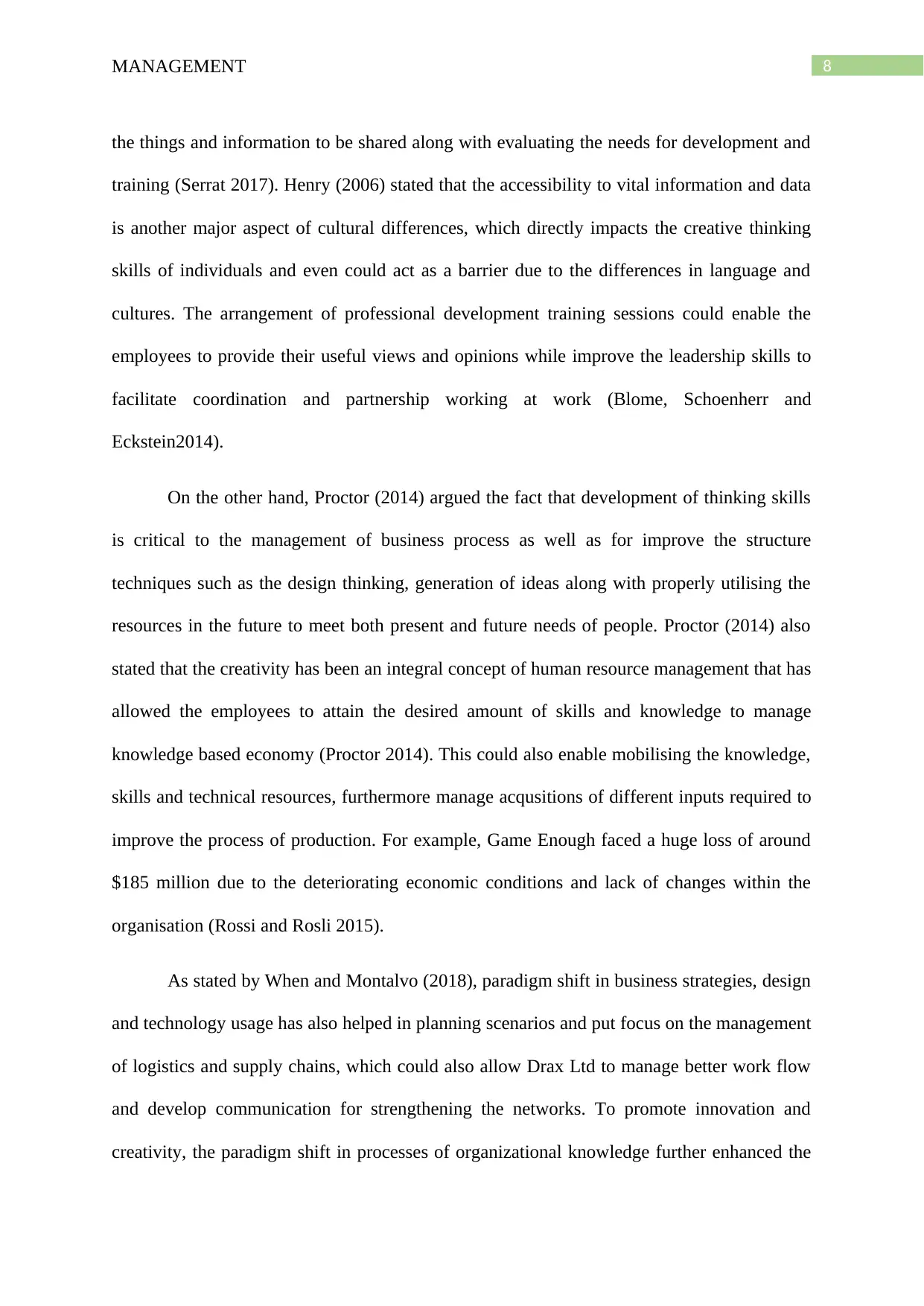
8MANAGEMENT
the things and information to be shared along with evaluating the needs for development and
training (Serrat 2017). Henry (2006) stated that the accessibility to vital information and data
is another major aspect of cultural differences, which directly impacts the creative thinking
skills of individuals and even could act as a barrier due to the differences in language and
cultures. The arrangement of professional development training sessions could enable the
employees to provide their useful views and opinions while improve the leadership skills to
facilitate coordination and partnership working at work (Blome, Schoenherr and
Eckstein2014).
On the other hand, Proctor (2014) argued the fact that development of thinking skills
is critical to the management of business process as well as for improve the structure
techniques such as the design thinking, generation of ideas along with properly utilising the
resources in the future to meet both present and future needs of people. Proctor (2014) also
stated that the creativity has been an integral concept of human resource management that has
allowed the employees to attain the desired amount of skills and knowledge to manage
knowledge based economy (Proctor 2014). This could also enable mobilising the knowledge,
skills and technical resources, furthermore manage acqusitions of different inputs required to
improve the process of production. For example, Game Enough faced a huge loss of around
$185 million due to the deteriorating economic conditions and lack of changes within the
organisation (Rossi and Rosli 2015).
As stated by When and Montalvo (2018), paradigm shift in business strategies, design
and technology usage has also helped in planning scenarios and put focus on the management
of logistics and supply chains, which could also allow Drax Ltd to manage better work flow
and develop communication for strengthening the networks. To promote innovation and
creativity, the paradigm shift in processes of organizational knowledge further enhanced the
the things and information to be shared along with evaluating the needs for development and
training (Serrat 2017). Henry (2006) stated that the accessibility to vital information and data
is another major aspect of cultural differences, which directly impacts the creative thinking
skills of individuals and even could act as a barrier due to the differences in language and
cultures. The arrangement of professional development training sessions could enable the
employees to provide their useful views and opinions while improve the leadership skills to
facilitate coordination and partnership working at work (Blome, Schoenherr and
Eckstein2014).
On the other hand, Proctor (2014) argued the fact that development of thinking skills
is critical to the management of business process as well as for improve the structure
techniques such as the design thinking, generation of ideas along with properly utilising the
resources in the future to meet both present and future needs of people. Proctor (2014) also
stated that the creativity has been an integral concept of human resource management that has
allowed the employees to attain the desired amount of skills and knowledge to manage
knowledge based economy (Proctor 2014). This could also enable mobilising the knowledge,
skills and technical resources, furthermore manage acqusitions of different inputs required to
improve the process of production. For example, Game Enough faced a huge loss of around
$185 million due to the deteriorating economic conditions and lack of changes within the
organisation (Rossi and Rosli 2015).
As stated by When and Montalvo (2018), paradigm shift in business strategies, design
and technology usage has also helped in planning scenarios and put focus on the management
of logistics and supply chains, which could also allow Drax Ltd to manage better work flow
and develop communication for strengthening the networks. To promote innovation and
creativity, the paradigm shift in processes of organizational knowledge further enhanced the
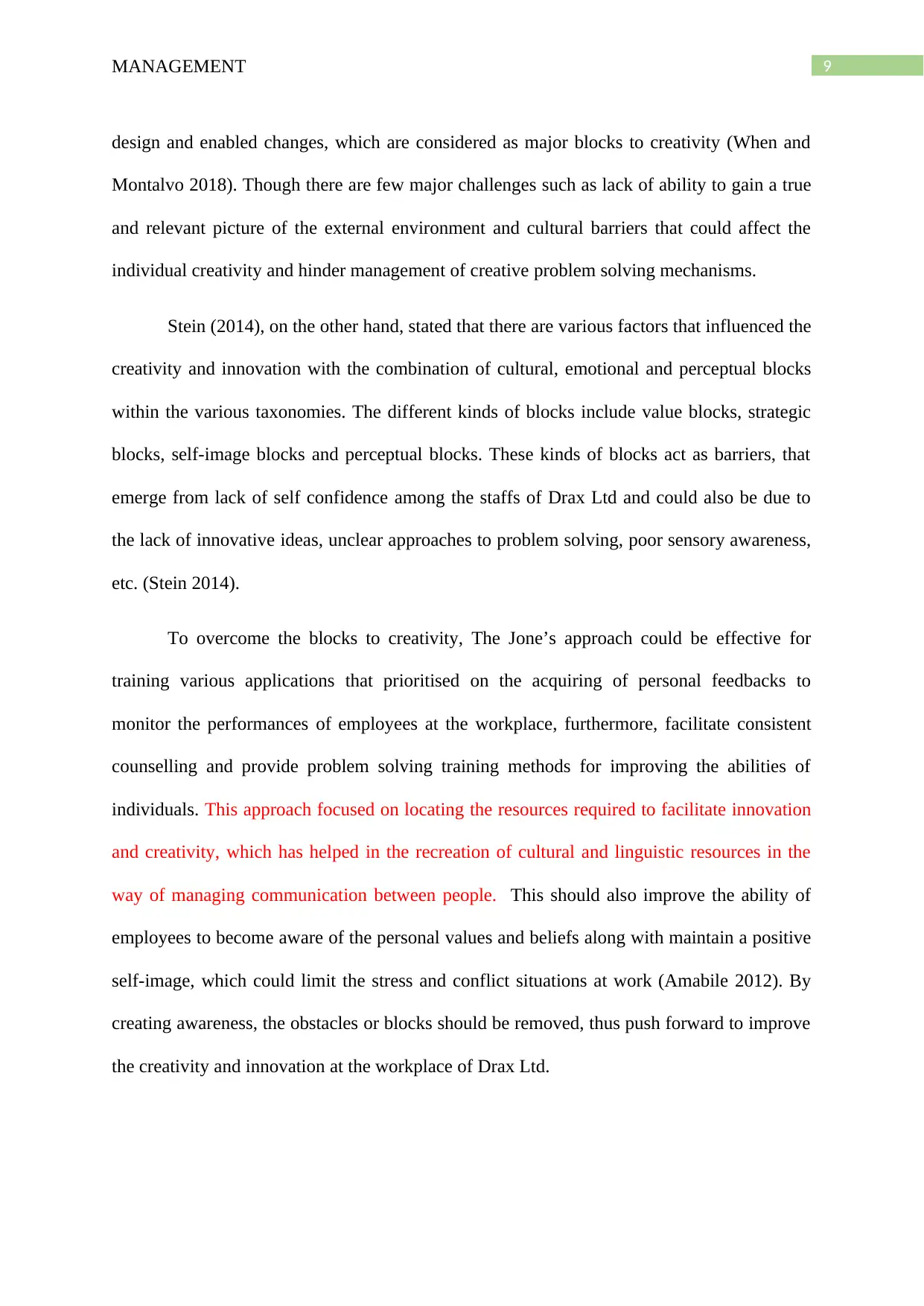
9MANAGEMENT
design and enabled changes, which are considered as major blocks to creativity (When and
Montalvo 2018). Though there are few major challenges such as lack of ability to gain a true
and relevant picture of the external environment and cultural barriers that could affect the
individual creativity and hinder management of creative problem solving mechanisms.
Stein (2014), on the other hand, stated that there are various factors that influenced the
creativity and innovation with the combination of cultural, emotional and perceptual blocks
within the various taxonomies. The different kinds of blocks include value blocks, strategic
blocks, self-image blocks and perceptual blocks. These kinds of blocks act as barriers, that
emerge from lack of self confidence among the staffs of Drax Ltd and could also be due to
the lack of innovative ideas, unclear approaches to problem solving, poor sensory awareness,
etc. (Stein 2014).
To overcome the blocks to creativity, The Jone’s approach could be effective for
training various applications that prioritised on the acquiring of personal feedbacks to
monitor the performances of employees at the workplace, furthermore, facilitate consistent
counselling and provide problem solving training methods for improving the abilities of
individuals. This approach focused on locating the resources required to facilitate innovation
and creativity, which has helped in the recreation of cultural and linguistic resources in the
way of managing communication between people. This should also improve the ability of
employees to become aware of the personal values and beliefs along with maintain a positive
self-image, which could limit the stress and conflict situations at work (Amabile 2012). By
creating awareness, the obstacles or blocks should be removed, thus push forward to improve
the creativity and innovation at the workplace of Drax Ltd.
design and enabled changes, which are considered as major blocks to creativity (When and
Montalvo 2018). Though there are few major challenges such as lack of ability to gain a true
and relevant picture of the external environment and cultural barriers that could affect the
individual creativity and hinder management of creative problem solving mechanisms.
Stein (2014), on the other hand, stated that there are various factors that influenced the
creativity and innovation with the combination of cultural, emotional and perceptual blocks
within the various taxonomies. The different kinds of blocks include value blocks, strategic
blocks, self-image blocks and perceptual blocks. These kinds of blocks act as barriers, that
emerge from lack of self confidence among the staffs of Drax Ltd and could also be due to
the lack of innovative ideas, unclear approaches to problem solving, poor sensory awareness,
etc. (Stein 2014).
To overcome the blocks to creativity, The Jone’s approach could be effective for
training various applications that prioritised on the acquiring of personal feedbacks to
monitor the performances of employees at the workplace, furthermore, facilitate consistent
counselling and provide problem solving training methods for improving the abilities of
individuals. This approach focused on locating the resources required to facilitate innovation
and creativity, which has helped in the recreation of cultural and linguistic resources in the
way of managing communication between people. This should also improve the ability of
employees to become aware of the personal values and beliefs along with maintain a positive
self-image, which could limit the stress and conflict situations at work (Amabile 2012). By
creating awareness, the obstacles or blocks should be removed, thus push forward to improve
the creativity and innovation at the workplace of Drax Ltd.
Paraphrase This Document
Need a fresh take? Get an instant paraphrase of this document with our AI Paraphraser
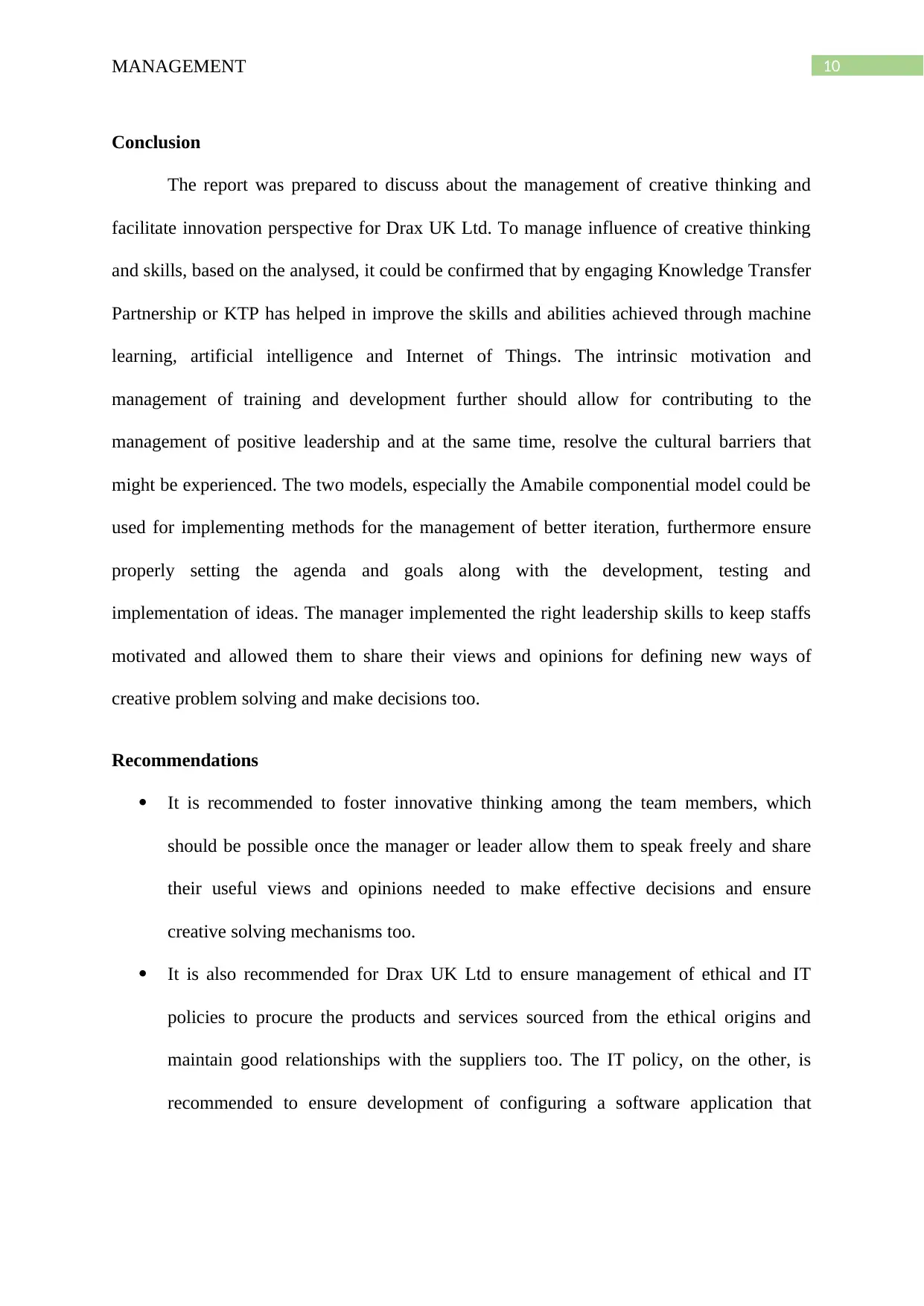
10MANAGEMENT
Conclusion
The report was prepared to discuss about the management of creative thinking and
facilitate innovation perspective for Drax UK Ltd. To manage influence of creative thinking
and skills, based on the analysed, it could be confirmed that by engaging Knowledge Transfer
Partnership or KTP has helped in improve the skills and abilities achieved through machine
learning, artificial intelligence and Internet of Things. The intrinsic motivation and
management of training and development further should allow for contributing to the
management of positive leadership and at the same time, resolve the cultural barriers that
might be experienced. The two models, especially the Amabile componential model could be
used for implementing methods for the management of better iteration, furthermore ensure
properly setting the agenda and goals along with the development, testing and
implementation of ideas. The manager implemented the right leadership skills to keep staffs
motivated and allowed them to share their views and opinions for defining new ways of
creative problem solving and make decisions too.
Recommendations
It is recommended to foster innovative thinking among the team members, which
should be possible once the manager or leader allow them to speak freely and share
their useful views and opinions needed to make effective decisions and ensure
creative solving mechanisms too.
It is also recommended for Drax UK Ltd to ensure management of ethical and IT
policies to procure the products and services sourced from the ethical origins and
maintain good relationships with the suppliers too. The IT policy, on the other, is
recommended to ensure development of configuring a software application that
Conclusion
The report was prepared to discuss about the management of creative thinking and
facilitate innovation perspective for Drax UK Ltd. To manage influence of creative thinking
and skills, based on the analysed, it could be confirmed that by engaging Knowledge Transfer
Partnership or KTP has helped in improve the skills and abilities achieved through machine
learning, artificial intelligence and Internet of Things. The intrinsic motivation and
management of training and development further should allow for contributing to the
management of positive leadership and at the same time, resolve the cultural barriers that
might be experienced. The two models, especially the Amabile componential model could be
used for implementing methods for the management of better iteration, furthermore ensure
properly setting the agenda and goals along with the development, testing and
implementation of ideas. The manager implemented the right leadership skills to keep staffs
motivated and allowed them to share their views and opinions for defining new ways of
creative problem solving and make decisions too.
Recommendations
It is recommended to foster innovative thinking among the team members, which
should be possible once the manager or leader allow them to speak freely and share
their useful views and opinions needed to make effective decisions and ensure
creative solving mechanisms too.
It is also recommended for Drax UK Ltd to ensure management of ethical and IT
policies to procure the products and services sourced from the ethical origins and
maintain good relationships with the suppliers too. The IT policy, on the other, is
recommended to ensure development of configuring a software application that

11MANAGEMENT
should be beta tested and soak tested for ensuring proper functioning of the product
and installation by the engineer too.
Maintenance of good leadership skills and arrangement of training sessions are
recommended as well for improving collaboration between team members while
taking into consideration their views and opinions for effective creating solving and
decision making.
The management of brainstorming sessions offline could also be beneficial for
encouraging the team memebrs and allow them to share their innovative ideas and
views require to facilitate creative thinking at Drax UK Ltd.
The formation of a diverse working environment is recommended too for resolving
cultural differences and at the same time, promote better ideas and options, which
should lead to better creative thinking and innovation
Being a provider of fire safety management services, the company needs to
incorporate environmental policies and principles to reduce carbon impact and make
necessary changes for benefiting the stakeholders as well as conserve natural
resources to create a positive impact on the environment largely.
should be beta tested and soak tested for ensuring proper functioning of the product
and installation by the engineer too.
Maintenance of good leadership skills and arrangement of training sessions are
recommended as well for improving collaboration between team members while
taking into consideration their views and opinions for effective creating solving and
decision making.
The management of brainstorming sessions offline could also be beneficial for
encouraging the team memebrs and allow them to share their innovative ideas and
views require to facilitate creative thinking at Drax UK Ltd.
The formation of a diverse working environment is recommended too for resolving
cultural differences and at the same time, promote better ideas and options, which
should lead to better creative thinking and innovation
Being a provider of fire safety management services, the company needs to
incorporate environmental policies and principles to reduce carbon impact and make
necessary changes for benefiting the stakeholders as well as conserve natural
resources to create a positive impact on the environment largely.
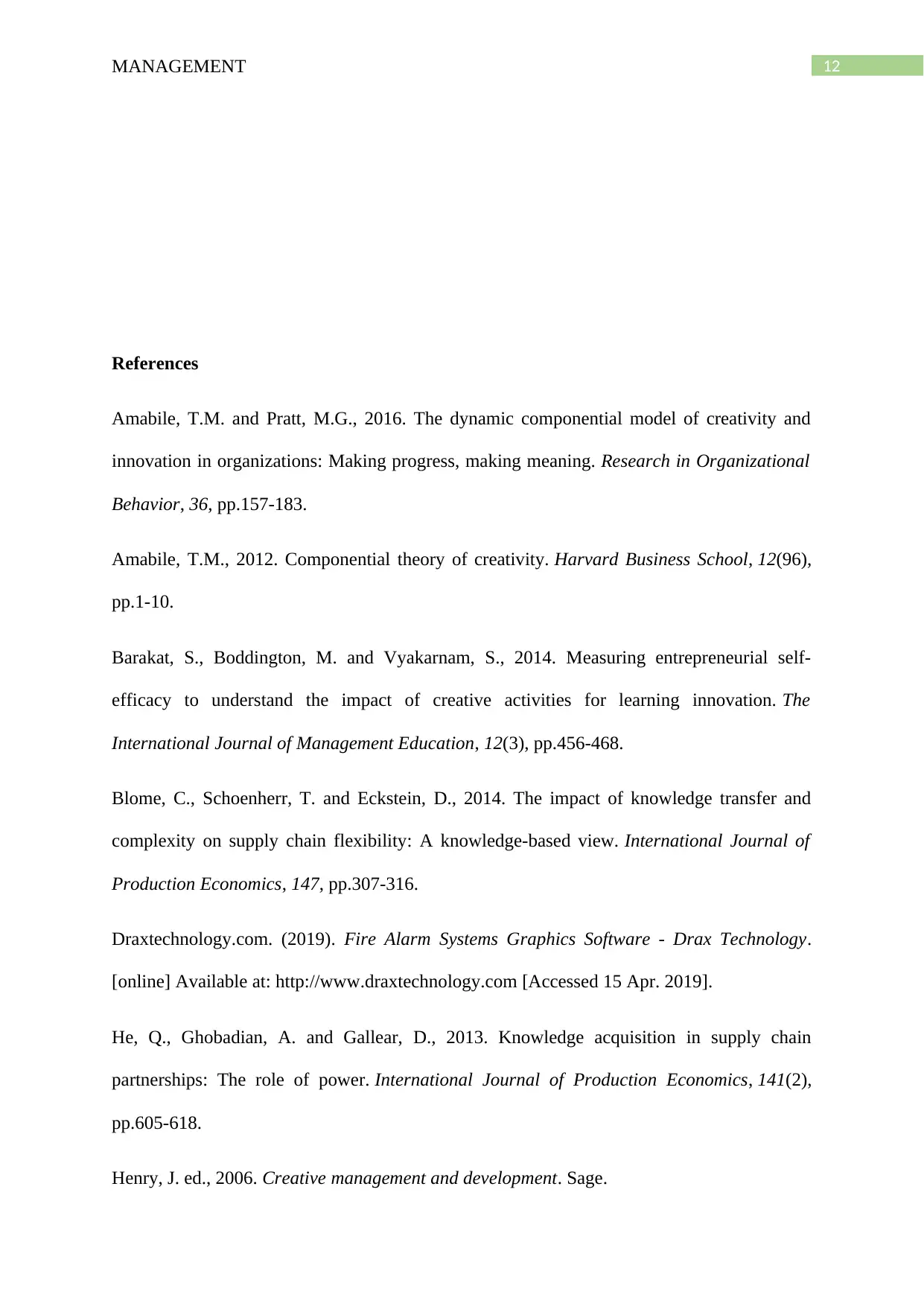
12MANAGEMENT
References
Amabile, T.M. and Pratt, M.G., 2016. The dynamic componential model of creativity and
innovation in organizations: Making progress, making meaning. Research in Organizational
Behavior, 36, pp.157-183.
Amabile, T.M., 2012. Componential theory of creativity. Harvard Business School, 12(96),
pp.1-10.
Barakat, S., Boddington, M. and Vyakarnam, S., 2014. Measuring entrepreneurial self-
efficacy to understand the impact of creative activities for learning innovation. The
International Journal of Management Education, 12(3), pp.456-468.
Blome, C., Schoenherr, T. and Eckstein, D., 2014. The impact of knowledge transfer and
complexity on supply chain flexibility: A knowledge-based view. International Journal of
Production Economics, 147, pp.307-316.
Draxtechnology.com. (2019). Fire Alarm Systems Graphics Software - Drax Technology.
[online] Available at: http://www.draxtechnology.com [Accessed 15 Apr. 2019].
He, Q., Ghobadian, A. and Gallear, D., 2013. Knowledge acquisition in supply chain
partnerships: The role of power. International Journal of Production Economics, 141(2),
pp.605-618.
Henry, J. ed., 2006. Creative management and development. Sage.
References
Amabile, T.M. and Pratt, M.G., 2016. The dynamic componential model of creativity and
innovation in organizations: Making progress, making meaning. Research in Organizational
Behavior, 36, pp.157-183.
Amabile, T.M., 2012. Componential theory of creativity. Harvard Business School, 12(96),
pp.1-10.
Barakat, S., Boddington, M. and Vyakarnam, S., 2014. Measuring entrepreneurial self-
efficacy to understand the impact of creative activities for learning innovation. The
International Journal of Management Education, 12(3), pp.456-468.
Blome, C., Schoenherr, T. and Eckstein, D., 2014. The impact of knowledge transfer and
complexity on supply chain flexibility: A knowledge-based view. International Journal of
Production Economics, 147, pp.307-316.
Draxtechnology.com. (2019). Fire Alarm Systems Graphics Software - Drax Technology.
[online] Available at: http://www.draxtechnology.com [Accessed 15 Apr. 2019].
He, Q., Ghobadian, A. and Gallear, D., 2013. Knowledge acquisition in supply chain
partnerships: The role of power. International Journal of Production Economics, 141(2),
pp.605-618.
Henry, J. ed., 2006. Creative management and development. Sage.
Secure Best Marks with AI Grader
Need help grading? Try our AI Grader for instant feedback on your assignments.
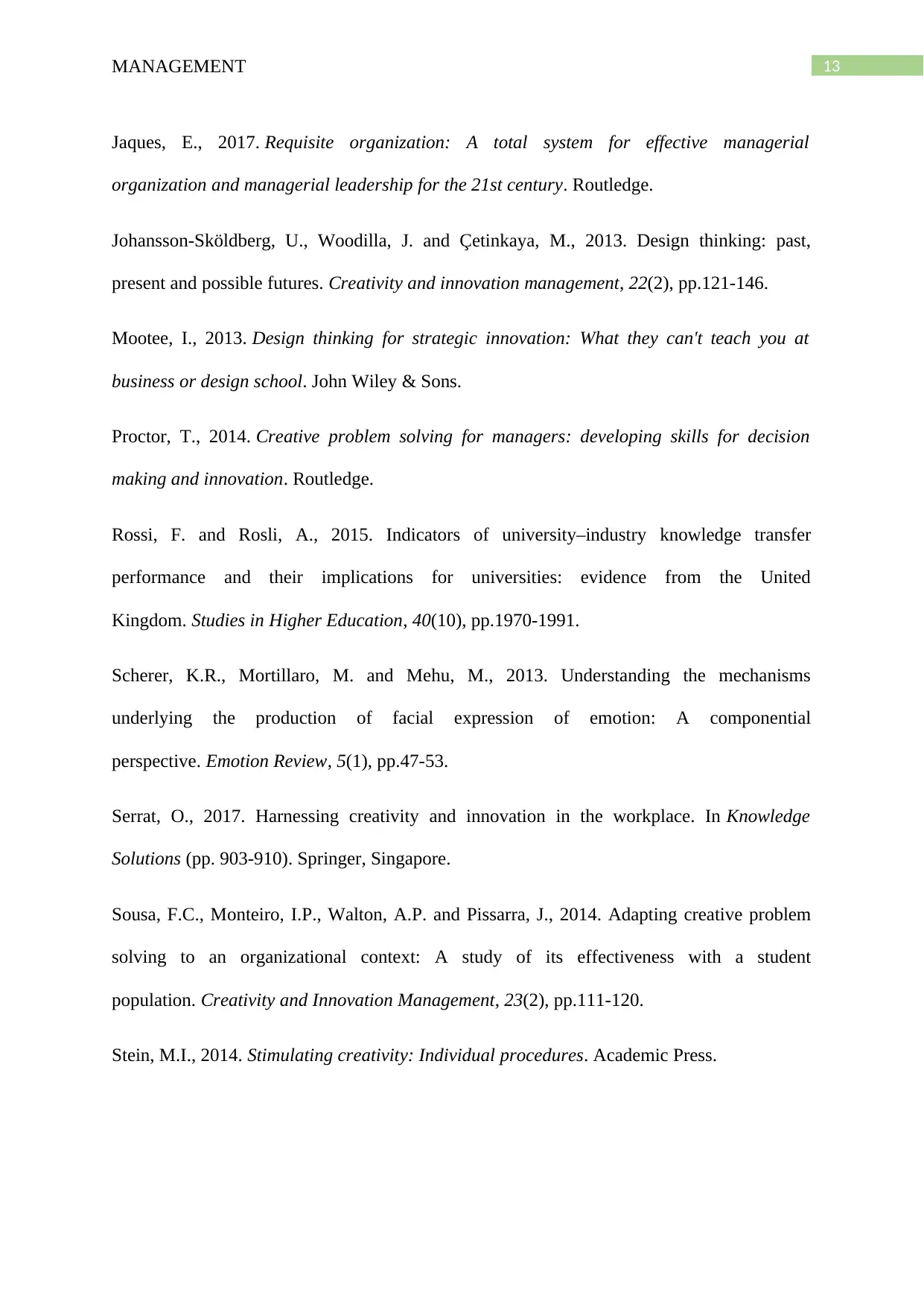
13MANAGEMENT
Jaques, E., 2017. Requisite organization: A total system for effective managerial
organization and managerial leadership for the 21st century. Routledge.
Johansson‐Sköldberg, U., Woodilla, J. and Çetinkaya, M., 2013. Design thinking: past,
present and possible futures. Creativity and innovation management, 22(2), pp.121-146.
Mootee, I., 2013. Design thinking for strategic innovation: What they can't teach you at
business or design school. John Wiley & Sons.
Proctor, T., 2014. Creative problem solving for managers: developing skills for decision
making and innovation. Routledge.
Rossi, F. and Rosli, A., 2015. Indicators of university–industry knowledge transfer
performance and their implications for universities: evidence from the United
Kingdom. Studies in Higher Education, 40(10), pp.1970-1991.
Scherer, K.R., Mortillaro, M. and Mehu, M., 2013. Understanding the mechanisms
underlying the production of facial expression of emotion: A componential
perspective. Emotion Review, 5(1), pp.47-53.
Serrat, O., 2017. Harnessing creativity and innovation in the workplace. In Knowledge
Solutions (pp. 903-910). Springer, Singapore.
Sousa, F.C., Monteiro, I.P., Walton, A.P. and Pissarra, J., 2014. Adapting creative problem
solving to an organizational context: A study of its effectiveness with a student
population. Creativity and Innovation Management, 23(2), pp.111-120.
Stein, M.I., 2014. Stimulating creativity: Individual procedures. Academic Press.
Jaques, E., 2017. Requisite organization: A total system for effective managerial
organization and managerial leadership for the 21st century. Routledge.
Johansson‐Sköldberg, U., Woodilla, J. and Çetinkaya, M., 2013. Design thinking: past,
present and possible futures. Creativity and innovation management, 22(2), pp.121-146.
Mootee, I., 2013. Design thinking for strategic innovation: What they can't teach you at
business or design school. John Wiley & Sons.
Proctor, T., 2014. Creative problem solving for managers: developing skills for decision
making and innovation. Routledge.
Rossi, F. and Rosli, A., 2015. Indicators of university–industry knowledge transfer
performance and their implications for universities: evidence from the United
Kingdom. Studies in Higher Education, 40(10), pp.1970-1991.
Scherer, K.R., Mortillaro, M. and Mehu, M., 2013. Understanding the mechanisms
underlying the production of facial expression of emotion: A componential
perspective. Emotion Review, 5(1), pp.47-53.
Serrat, O., 2017. Harnessing creativity and innovation in the workplace. In Knowledge
Solutions (pp. 903-910). Springer, Singapore.
Sousa, F.C., Monteiro, I.P., Walton, A.P. and Pissarra, J., 2014. Adapting creative problem
solving to an organizational context: A study of its effectiveness with a student
population. Creativity and Innovation Management, 23(2), pp.111-120.
Stein, M.I., 2014. Stimulating creativity: Individual procedures. Academic Press.
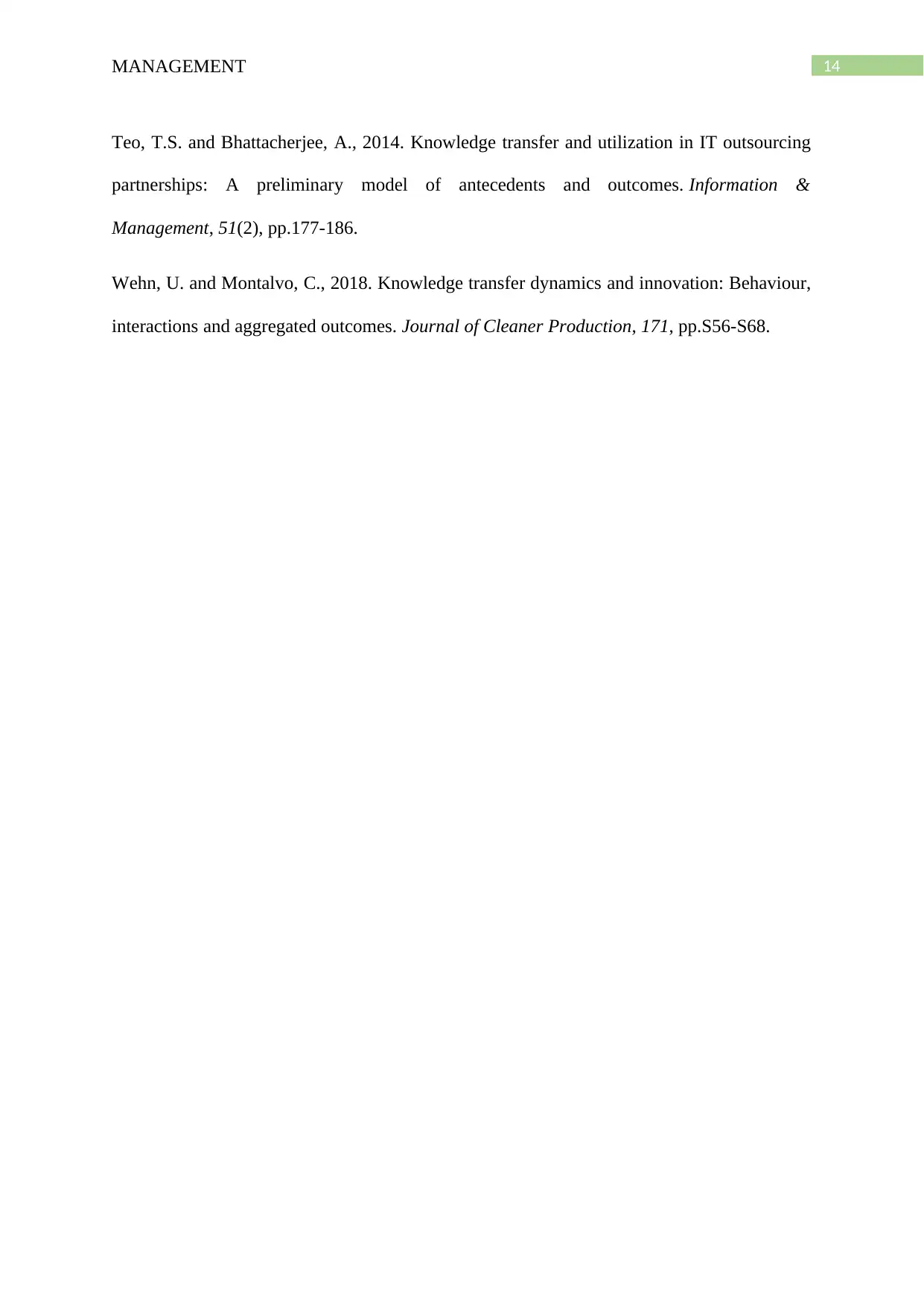
14MANAGEMENT
Teo, T.S. and Bhattacherjee, A., 2014. Knowledge transfer and utilization in IT outsourcing
partnerships: A preliminary model of antecedents and outcomes. Information &
Management, 51(2), pp.177-186.
Wehn, U. and Montalvo, C., 2018. Knowledge transfer dynamics and innovation: Behaviour,
interactions and aggregated outcomes. Journal of Cleaner Production, 171, pp.S56-S68.
Teo, T.S. and Bhattacherjee, A., 2014. Knowledge transfer and utilization in IT outsourcing
partnerships: A preliminary model of antecedents and outcomes. Information &
Management, 51(2), pp.177-186.
Wehn, U. and Montalvo, C., 2018. Knowledge transfer dynamics and innovation: Behaviour,
interactions and aggregated outcomes. Journal of Cleaner Production, 171, pp.S56-S68.
1 out of 15
Related Documents
Your All-in-One AI-Powered Toolkit for Academic Success.
+13062052269
info@desklib.com
Available 24*7 on WhatsApp / Email
![[object Object]](/_next/static/media/star-bottom.7253800d.svg)
Unlock your academic potential
© 2024 | Zucol Services PVT LTD | All rights reserved.